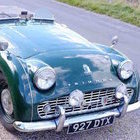-
Forum Statistics
10.2k
Total Topics155.5k
Total Posts
-
Recent Posts
-
I'm trying to stay on task and my made up deadline of having it running on fuel injection over the christmas break is rapidly approaching. GRP components are on hiatus as I try and get the paint and fixings good. Below is a summary of recent progress and is intended for informaition and critique! I now have the fuel rail mounted up with the smaller injectors so the new inlet plenum construction should be easier. I've mounted the swirl pot and high pressure pump in the boot, and run the new high pressure fuel line under the car. I soldered olives onto the copper tube to give hose clamps something to grip onto. The car runs using the new high pressure fuel line which I intend to keep using to ensure it flushes out any muck or swarf generated during manufacture which will hopefully stop in the float bowls. I need some more 8mm copper tube, as I intend on minimising rubber hose in the engine bay as my recent experince is of it barely lasting 12 months. I've bought some Cohline 2240 for this install so I'll hope it lasts longer than the current stuff. Where I route copper under the bonnet I'll probably put it in some sorf of jacket to minimise heat pickup. In the boot my plan is for the standard fuel feed from the tank to run to basic filter, then thorugh the facet pre-filter. Facet pumps to swirlpot (2). Swirlpot vents back to blocked off breather fitting at the top of the tank* (4). High pressure pump runs to new high pressure fuel pipe, via 10 micron filter (1), and old fuel supply becomes lower pressure retrun (3) One snag realised today is that the high pressure fuel pump is capable of drawing 30A. I don't think it will draw that, and while the fuses and relays are rated to this I need to run a heavier gauge wire to the boot to supply it and the local Wilcos don't have the right colour or length. I'm also slightly concerned that the high pressure pump is rated for significantly more than the low one, so the high pressure loop could be running harder than the low pressure one. Not a showstopper, but could lead to heatsoak in the fuel and swil pot, so I'll have to keep an eye on that. Hopefully the two copper fuel lines running the length of the car will help dissipate any heat absorbed in the engine bay. Getting the fuel line made up feels like a significant milestone though. One question I have is how best to fix the fuel line under the car. Drilling the chassis to put in rivnuts feels wrong, but so does drilling the floor. Cabletying to the other fuel and brake lines feels ok, but metal clips might chafe and plastic ones feel insufficient. *I'm slightly worried this will create a waterfall of petrol in the main tank which will stir up any and all crap in the tank and block all my filters. I've been warned of this by someone who got so fed up they bhought a new fuel tank to solve the issue. I'd thought about using a TR7 fuel sender which has a fuel connection for the fuel return, but I'm not sure if they are interchangable with a spitfire and I understand they aren't really accessible without a jack/lift/pit so are hard to measure. A cleanable bronze filter to replace the plastic one I currently have feels sensible. Edit: numbers below are for intended setup. Current setup is low pressure pump through newly installed fuel pipe.
-
By Nick Jones · Posted
Brexit…. The “gift” that just keeps on taking…. -
By Nick Jones · Posted
Well, yes! I must admit that it was a mode of failure I’d foreseen. Most unwelcome. Also that spares availability is so poor. It’s only 30 years old….. Latest is that there is one glass left in the country but I can’t have it as it’s not “correct” for the model. Something to do with the high level brake light. My response: you get the glass and stick it on. I’ll worry about the brake light…. We’ll see. -
By Nick Jones · Posted
I’d be checking the heating element for continuity first, then if that’s good, it’s a controls problem. Either it thinks there’s no water in it (if there’s any sensor to tell it) or it thinks it’s overheating (Robs switch). This last is a good shout as those switches aren’t especially reliable. Should be fairly easy to find a replacement - the trip temperature is usually marked on them. -
That white circular thing with the white and red wires is a bi-metallic thermal switch. It turns the machine off if the element overheats as it might do if the water flow is restricted. It is probably supposed to self-reset but they sometimes fail..... Looks to me as if it is just wired in series with the heater element.
-
It doesn't. Sadly many people are simply not getting the help they desperately need.
-
By RedRooster · Posted
According to South Park, they are not very dangly at all... -
By RedRooster · Posted
Circuit board doesn't look very much and seems to have discrete components which is good. It's probably the temperature sensor u/s, you could try testing that first. Is it a E61 group head machine? -
(apols, just getting used to a chromebook, works a bit different to my old windows lappy)
-
Perhaps trivial, compared to the above, but my Tower coffee maker has stopped working. It's not yer all singing and dancing , chromium plated for the semi-professional barista but a machine that I fill with water and coffee beans. It then grinds the beans and percs the water through them, delivering the coffee into a jug that I can pour into a mug. Simples! But it's stopped working - or rather it's stopped heating. Grinds the beans, and then nilch. I took it back to the chain white goods supermarket I bought it from , a bit too long ago for any hope of a fix under guarantee. They were very nice about it, even looked up when I bought it - yup, guarantee run out. Could they fix it? No. And they gently pointed out that even if I could find a workshop to diagnose and mend it it, it would cost more than a new one. And they no longer stock what I have. Thank you and good day. But, inspired by the self-fixing heroes above, I took it home and took off the base, only six screws. Inside the way it works became obvious: Not shown in my pic is the top, where a removeable container sits, that you put the beans and water into. At the bottom of the pic is a hot plate that the jug sits on top of. A U-shaped channel, held on by a cross bar, obviously heats the water and the hot plate It holds a ?transistor/?heat sensor and is wired to the circuit board above, as is the electric motor (above it in the pic) that drives the grinder. Two hoses feed the heater, one with a Y-connection on it, that comes from the water container through a passive valve, there so that the water doesn't fall out before you put it in the machine. (Left side in the pic) The water goes though the heater and is squirted onto the ground beans via the right hand hose, from where it goes through a mesh into the jug. Again, simples. But it won't heat. No broken or loose wires. What do you think, O Gurus of the Angry Pixies, aka electrons. Is the fault in the circuit board (about 2 o'clock in the pic)? Accessible if I do a bit more dismantling, but unlikely that could replace anything on it. Or is it the heater itself? Probably ditto Thanks for any thoughts! John PS While in the white goods supermarket, I did look for a replacement. Gosh! Dozens of devices in the all singing and dancing , chromium plated semi-professional barista line, all costing upwards of £150. One - just one - that looked as if did the same as mine, and cost what I consider to be a reasonable price. So if you can, please, I'd like to fix this one? J.
-
-
Topics





